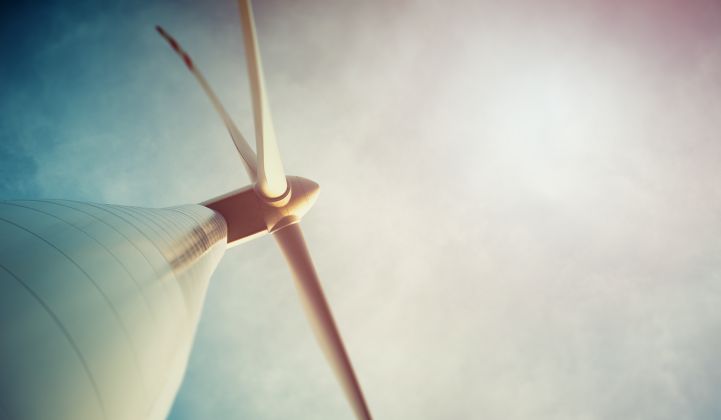If you’ve ever driven alongside a truck hauling wind turbine components, the limitations are immediately obvious. The enormity of the blades and tower segments make it difficult to transport the materials on highways to the project site.
A California startup thinks it’s found a workaround. RCAM Technologies was recently awarded a $1.25 million grant from the California Energy Commission (CEC) to develop and test 3-D printing technology enabling the construction of concrete turbine towers in place at the project site.
The average tower height for turbines installed in the United States is just over 80 meters. RCAM Technologies, founded by National Renewable Energy Laboratory (NREL) alumnus Jason Cotrell, wants to use reinforced concrete additive manufacturing technology -- a form of 3-D printing -- to erect towers 140 meters or higher. Cotrell left NREL in May to pursue grant funding to develop the technology.
Based on estimates derived using NREL’s levelized cost of energy (LCOE) modeling tools, the company expects that a 140-meter tower would increase electricity production by more than 20 percent at a site with moderate wind shear. By enabling turbines to reach steadier, stronger winds, the ultra-tall towers would boost capacity factors and generate electricity at lower cost.
According to the grant request form submitted to the CEC, at scale, the market-ready 3-D printing technology envisioned by RCAM Technologies “will enable fabrication of a wind turbine tower onsite, in one day at half of the cost of conventional steel towers, and reduce the levelized cost of wind generated electricity in a low wind speed site by 11 percent.”
Digital concrete
“When you’re building a wind plant, you want to build the wind turbines as tall as you possibly can to capture the faster wind aloft,” said Cotrell in an NREL video. “However, when you’re building tall wind turbines, the tower diameters become so large that they’re difficult to transport over the roads. With this technology, what we’re able to do is manufacture those towers onsite using an automated concrete manufacturing process that allows us to bypass the transportation and logistics constraints.”
Under its agreement with the California Energy Commission, RCAM Technologies will design the lower half of two ultra-tall hybrid turbine towers between 140 meters to 170 meters. The upper half of the towers will use conventional tapered steel tower sections; the lower half of the towers will be constructed with reinforced concrete additive manufacturing technology. Prototype sections of the concrete towers will be fabricated using a robotic arm and 3-D printer, and will be tested at the University of California, Irvine.
In a real-world deployment, RCAM Technologies expects the large-diameter concrete tower sections to be fabricated onsite with concrete supplied by standard concrete trucks or an existing concrete batch plant such as the one used to prepare the tower foundations.
Potential to boost capacity factors
According to NREL, the best wind power sites in the Great Plains are posting annual capacity factors today of more than 50 percent with 80-meter towers. Taller towers would make wind power economically competitive in more regions.
“Outside of the centrally located wind belt, average performance does not yet meet the levels required to compete with low-priced natural gas and (increasingly) low-cost solar photovoltaics, particularly in an era of relatively low load growth,” said a team of NREL researchers in a presentation on tall wind turbine technologies delivered at an American Wind Energy Association conference in May of this year.
“To broaden the geographic reach of wind power, a continued evaluation of tall tower technology appears to be merited,” the team added. “Achieving higher hub heights can still drive significant improvements in capacity factor throughout broad regions of the country.”
Path to market, partnering with UC Irvine
“Concrete towers have quickly emerged as a cost-effective alternative to steel tubular towers for hub heights over 120 meters,” said Aaron Barr, a senior consultant with MAKE Consulting, in an email. MAKE Consulting is owned by Wood Mackenzie, Greentech Media’s parent company.
Barr noted that concrete wind towers have been deployed for a decade in Europe. But most of the concrete towers built there have used precast concrete sections manufactured elsewhere and shipped in multiple segments to the project site. RCAM Technologies’ process would avoid those logistical constraints by pouring concrete on site.
“Performing on-site pouring of concrete towers can present some cost savings in logistics and material cost,” he added, “and present one of the most promising applications of 3-D printing in the wind energy industry.”
Barr cautioned that 3-D printing could increase the time required to install turbines. “The specialized equipment and concrete curing times would significantly increase the construction cycle of a typical wind plant,” he said. “Most U.S. wind plants are able to install turbines at a pace of one turbine per day or faster, given that all turbine equipment has been delivered to on-site staging areas. Use of an in-situ concrete tower solution dramatically increases this installation cycle, adding cost and execution risk to the wind plant development.”
Can RCAM Technologies build 3-D-printed concrete turbine towers as fast and as cheaply as it estimates? Construction and testing of a prototype will be done in partnership with UC Irvine at the school’s civil engineering laboratory.
As part of a technology-to-market program at NREL called Energy I-Corps, Jason Cotrell and colleague Scott Jenne interviewed 75 wind turbine manufacturers and project developers.
“We found out,” said Cotrell in the NREL video, “that another wind turbine manufacturer had been exploring a very similar technology. We’ve been in contact with that manufacturer and expect to be partnering with that manufacturer going forward.”
In an email, Cotrell confirmed that RCAM Technologies is discussing partnership opportunities with several wind turbine manufacturers, including the unnamed company mentioned in the video.
RCAM Technologies’ agreement with the CEC notes that if the technology could increase the wind capacity deployment potential for new sites and repowered sites in California nearly tenfold -- from 6 gigawatts to 60 gigawatts.




